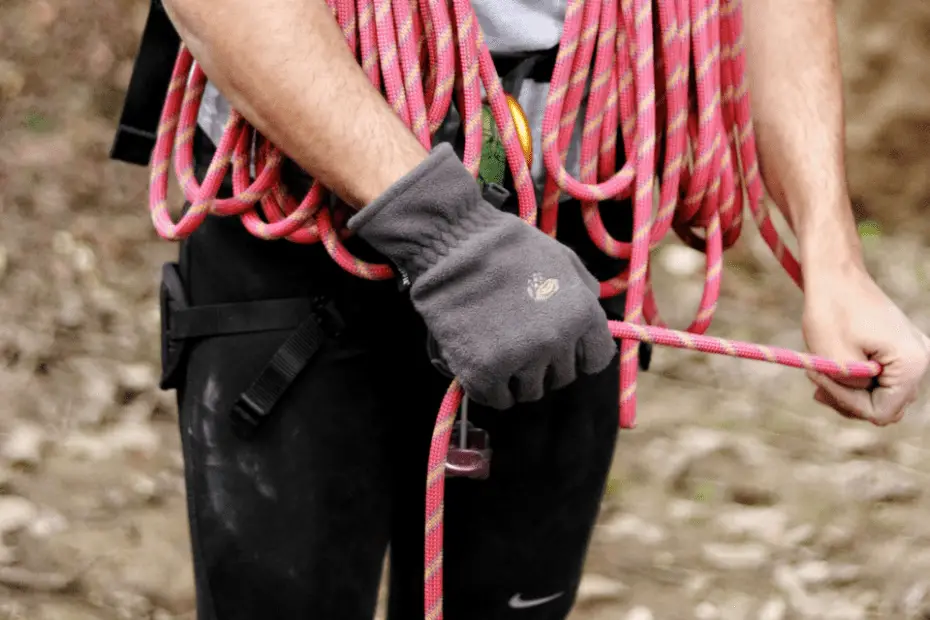As someone new to the world of climbing, I have often wondered about the impact it is having on my hands, applying chalk and gripping the rock face. every time I climb. So I decided to find out, can you wear gloves rock climbing? My thinking is that wearing gloves will help protect my hands from bumps and scrapes as well as potentially improve my grip on holds.
Well, what I found out was quite surprising. Read on to discover whether you should wear gloves when climbing.
For those short on time, yes you can wear gloves rock climbing, however, you will lose the ability to feel the holds with your fingers as well as reduce the amount of grip on the wall. There are some exceptions to this, which you can find out about in the guide.
Read on to find out more about wearing gloves when climbing.
How Important Are Your Hands When Climbing?
Whether you are climbing indoors on a specially designed climbing wall or climbing outside on the rock face, your hands and feet are the most important tools you will use to get you up the wall.
Your hands, and more specifically your fingers do two jobs when working your way up a wall.
The first job they will do is feel the wall for the right place to hold on to. Using your fingertips, you are feeling the surface to see what amount of friction there is (or lack of friction) and also how secure the grip is as well.
The second job your fingers will do is actually hold you on the wall. Once you know that a particular hold has enough friction for your hold, you will then grip the wall with your fingers, holding yourself securely and allowing for the next move with your feet.
In order for your hands to perform these two jobs successfully, most importantly the first job, being able to receive the required feedback from your fingers is vital, particularly on trickier climbing routes.
Why People Don’t Wear Gloves Rock Climbing

Now we know the importance of our hands when climbing, let’s think about this process when wearing gloves.
This first issue will be that when wearing gloves, you will lose the ability to feel the friction as well as you can without gloves. This will make it difficult for you to work out the right placement for your fingers on the hold and could lead to you getting a poor grip on the hold.
The second issue is that when you have positioned your hand, unless the gloves have a significant amount of friction on the inside, or they are skin-tight, your fingers will move inside the glove. This will ultimately mean that you have significantly less grip on the hold compared to if you weren’t wearing the gloves.
Based on these two reasons, gloves are not particularly practical. However, this is really only applicable when thinking about more difficult climbs and not your simpler climbs, where the holds might be much easier.
Reasons You Might Choose To Wear Gloves Rock Climbing
Whilst there are plenty of reasons that you might choose not to wear gloves when rock climbing, here are a few benefits to wearing gloves when climbing:
Improve Your Grip
Ok, so I’ve just said that wearing gloves reduces the friction on the wall, but bear with me here.
Sometimes when climbing you will find that the rock you need to grip onto is very smooth. In these scenarios, rubber palmed gloves will provide for more grip than your bare hands and climbing chalk ever could. You would just have to make sure the gloves are tight so that your hand doesn’t slip around inside of them.
To Keep Your Hands Warm
Cold hands will be less sensitive when climbing the wall. Gloves will help to keep your hands warm and avoid your fingers going numb.
Not as much of an issue when climbing indoors or in warmer weather, but something to consider if you are climbing in colder conditions.
Situations Where You Might Wear Gloves When Rock Climbing

Whilst wearing climbing gloves on trickier climbs might not be a good idea, don’t take them out of your climbing gear bag just yet as there are some occasions where it might actually be useful to wear gloves when climbing:
Crack Climbing
Crack climbing, where you follow the natural cracks that appear in a rock face, is one example of where wearing gloves can be useful.
One of the techniques when crack climbing is jamming, where an entire body part is inserted into the crack to create friction on both surfaces. This friction, as opposed to gripping a hold, is what stops you from falling.
As you can imagine, sticking your bare hand into a crack to create friction is a recipe for cuts and grazes on your hands, in particular the back of your hands where the skin is thinner and more sensitive. In this situation, some climbers will either heavily tape their hands up to protect them, or wear a pair of fingerless gloves. This will allow you to jam your hand into a crack without needing to worry about ruining your hands for the rest of the climb.
Belaying Another Climber
When acting as the belayer to another climber, your hands can often get cold and sore, depending on the conditions. You are also at risk of getting rope burn as the rope slides through your brake hand.
In these situations, some climbers will choose to wear gloves in order to protect their hands and make sure it doesn’t spoil the rest of their days climbing.
Abseiling or Repelling Down The Wall
When your abseiling (also know as repelling) down the wall, the rope you are using will need to feed through your hand. You control the speed of the drop with your hands as well.
As such, a moving rope through gloveless hands is the perfect recipe for rope burn. In this situation, a lot of climbers will choose to wear gloves in order to protect their hands. This is especially useful if you are dropping down to your climbing starting point and want to protect your hands ahead of starting your descent.
Colder Climbing Conditions
If you’re anything like me, colder conditions can play havoc with your skin. I often end up with cracked skin from being out in the cold. In addition to this, cold weather can also make my fingers go numb, which I’m sure is the same for many other climbers.
Taking some gloves with you for those moments when you are waiting around before you climb will help to keep your hands warm and stop your fingers from going numb. Remember, for a climber, being able to feel the friction with your fingers is vital for getting a good grip. Having numb fingers will reduce your feeling and therefore reduce your ability to get the right hold.
On An Easy Climbing Route
For some easier climbs, where it will be more like a scramble than a climb, the feedback from your fingers is not as necessary compared to more challenging climbing routes. In these situations, wearing gloves will not significantly reduce your ability to climb, but will protect your hands.
The positives of wearing your gloves will outweigh the negatives when tackling easier climbs.
Is Rock Climbing Bad For Your Hands?

When considering whether climbing is bad for your hands, you need to think about the impact on your bones/joints as well as the impact on your skin.
There is no denying that climbing puts you are increased risk of cuts and scrapes. In addition to this, the over use of climbing chalk can dry out yor hands faster than if you don’t use chalk. So in terms of your skin, climbing is bad for your hands, but the amount of damage that could occur is fairly limited.
When thinking about your bones and joints, things become a little trickier.
One study has looked into the affect of climbing on the hands and the increased likelihood of developing osteoarthritis (OA). The study aimed to find a link between climbing and an increased chance of developing OA, however they found the opposite to be true, with the climbers having a lower chance of developing OA.
Whilst this study is great news for most climbers, it should be noted that this is only one study and there are no doubt other stories that you will hear of people developing OA that they think is due to regular climbing.
So whilst there are risks of injury to your hands when climbing, you shouldn’t be put off doing it altogether. Just be aware of the risks and mitigate them where possible, such as wearing gloves when you can.
Summary
So now you know, most climbers will choose not to wear gloves when climbing, particularly when traversing a particularly tricky route. However, there is nothing to stop you from wearing gloves when climbing to ensure your hands are protected.
If you liked this guide, please share it on Pinterest. Also, please check out our other guides to all things outdoors.
Happy climbing!



